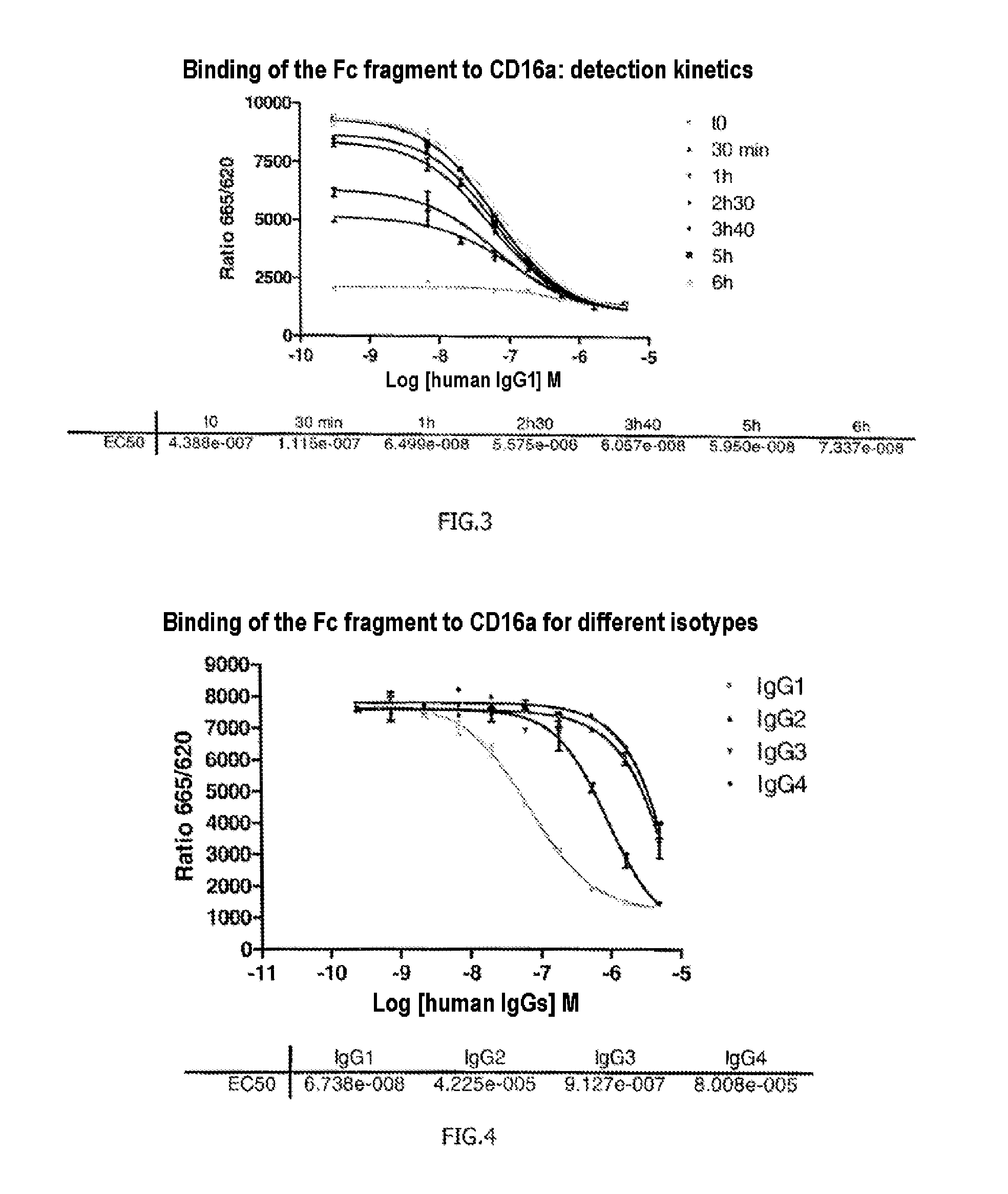Method for determining the glycosylation of an antibody
a glycosylation and antibody technology, applied in the field of antibody glycosylation methods, can solve the problems of expensive equipment that requires a certain level of expertise, little is known about the manner of action of antibodies in patients, and the current methods available for studying the binding of antibodies to fc receptors are relatively tedious
- Summary
- Abstract
- Description
- Claims
- Application Information
AI Technical Summary
Benefits of technology
Problems solved by technology
Method used
Image
Examples
example 1
Material and Method
Reagents Used:
[0114]Culture Medium: DMEM / Glutamax+10% FCS+streptomycin (50 μg / ml), penicillin 50 U / ml, HEPES 2 mM, nonessential amino acids 1% (InVitrogen)
[0115]OptiMEM: culture medium used for transfection, Invitrogen
[0116]Lipofectamine 2000: Invitrogen
[0117]SNAP-CD16A plasmid: prepared by inserting the nucleic acid sequence (SEQ ID No. 4) coding for the CD16a receptor (variant V158 (or V176) ref. Genbank NM—000569.6, protein sequence NP—000560.5) in the plasmid SNAP-tag® pT8-SNAP-Neomycin (Cisbio Bioassays), see FIG. 1.
[0118]Plasmid gamma chain of the FcεRI receptor: The DNA sequence (SEQ ID No. 5) coding for the gamma chain of the FcεRI receptor was inserted in an expression plasmid by the classical techniques. The map of this plasmid is shown in FIG. 2. It is known that the CD16a receptor forms dimers with this gamma chain, and it is therefore recommended to coexpress the two proteins. The inventors nevertheless discovered that this coexpression was not necess...
example 2
[0130]The cells prepared by the method described in example 1 were thawed at 37° C. and quickly mixed with 15 ml of PBS. The suspension obtained was centrifuged for 5 min at 1200 rpm and the supernatant was removed. The pellet was resuspended in Tag-lite® buffer to obtain a suspension for distributing HEK-CD16a-Tb cells in the wells of a 384 LV multiwell plate at a concentration of 10 000 cells per well under 10 μl.
[0131]An unlabeled human antibody of IgG1 isotype (its epitope specificity is unimportant) was added at different final concentrations from 0.3 nM to 5 μM under 5 μl.
[0132]The same antibody, labeled with the d2 fluorophore acceptor (d2 labeling kit Cisbio Bioassays, ref. 62D2DPEA), was added at 200 nM under 5 μl for a final concentration of 50 nM.
[0133]The FRET signals emitted by the 384 plate were measured immediately, then after 30 min, 1 h, 2 h30, 3 h40, 5 h and 6 h.
[0134]The results presented in FIG. 3 show that the method according to the invention allows effective m...
example 3
[0135]Example 2 was reproduced but this time the unlabeled IgG1 antibody (competing antibody) was replaced with human antibodies of isotypes IgG2, IgG3 and IgG4 (their epitope specificities are unimportant), which are known not to have as good affinity for the receptor CD16a as the antibodies of the IgG1 type. After adding different concentrations of these antibodies, the reaction mixture was incubated for 4 h20.
[0136]The results presented in FIG. 4 confirm what was known in terms of affinity of IgG2, IgG3 and IgG4 for the CD16a receptor and therefore validate the method according to the invention, which allows effective comparison of a reference antibody with other antibodies and which is sufficiently sensitive to allow visualization of differences in affinity of these antibodies, here for the CD16a receptor.
PUM
| Property | Measurement | Unit |
|---|---|---|
| incubation time | aaaaa | aaaaa |
| Time Resolved FRET | aaaaa | aaaaa |
| Time Resolved FRET | aaaaa | aaaaa |
Abstract
Description
Claims
Application Information
 Login to View More
Login to View More - R&D
- Intellectual Property
- Life Sciences
- Materials
- Tech Scout
- Unparalleled Data Quality
- Higher Quality Content
- 60% Fewer Hallucinations
Browse by: Latest US Patents, China's latest patents, Technical Efficacy Thesaurus, Application Domain, Technology Topic, Popular Technical Reports.
© 2025 PatSnap. All rights reserved.Legal|Privacy policy|Modern Slavery Act Transparency Statement|Sitemap|About US| Contact US: help@patsnap.com



